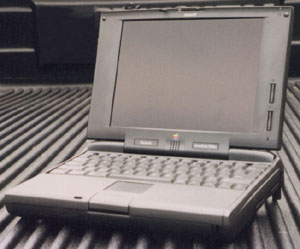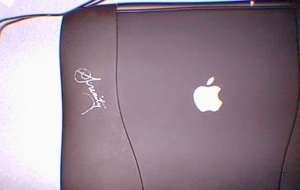As I said in my last entry, Macintoshes are more than mere personal computers. Fifteen years ago, I believed this as a matter of course. I was a rabid fan of Macs, mainly because I was unimpressed by PCs. I started working with computers back in 1980, when Mom would bring a computer home to play with/learn on over the weekends. One of these, incidentally, was one of the original Compaqs, which were early “portable” computers similar to the old Osbornes but bigger–about the size of an inconvenient briefcase, and about 40 pounds, as I recall.
Anyway, other than forays into BASIC on various TRS-80s, I didn’t do much with computers. They didn’t click with me, though the early work with BASIC would pay me huge dividends career-wise later on. I mean HUGE.
In the interim, there was the rest of my days. I went to a couple of computer shows with Dad back in 1982 and 1983, and saw the Apple Lisa, the Macintosh’s immediate predecessor which was targeted toward corporations. I will admit that at the time I was so inured with the command line concept, it was so soaked into me, that I thought the Lisa interface was interesting, but I just didn’t get it. From a computer standpoint, it didn’t have a command line, so I couldn’t see how you could talk to it. How to program it.
Of course, this was an early example of that hackneyed expression paradigm shift. Fans of the dot-com era will remember that one fondly. At the last Macworld I went to, back in 1996, that term was flying around thick and fast. By then I was a true believer in the Mac. Windows was a hopeless rip-off of what Apple did first and so much better, and Bill Gates was a filthy thief.
Now while I still believe the latter notion, that Gates is a filthy thief, I know now that the former idea was nonsense. Apple and Microsoft both took their interface cues from Xerox, such is the stuff of history. But again, I was a true believer because everything I ever asked from the various Macs I owned and worked with at that point, they could do. Pink cloud here.
Anyway, let me introduce you to some of my old girlfriends.

Sheena 2, circa 1999. Complete with awesome trackball, 2x CD-ROM drive with cartridge feed and ZIP drive.
Sheena 2 started life as a Macintosh SE. The first Sheena was a computer I used where I worked at the time. When I had the chance to buy a Mac of my own, it seemed logical to go after something like what I worked with. The original machine was purchased for $400 from a kid at Harvard. By the time this picture was taken, the only piece left of that old machine was the back plastic shell. I’d upgraded it to the vastly superior SE/30 first, given it 32 MB RAM (the maximum it could hold, if I recall correctly, though you had to install a piece of software to make it read all that RAM), then upgraded it to a faster processor and a grayscale adapter so it could show 256 shades of gray on that little screen. This was ostensibly so that, if necessary, I could assemble the Seacoast Times on this machine if the main production machine died (which it nearly did thanks to the fool who did layout for the paper before I got there). To fit all that equipment in that little box took some doing, and if I’d thought about it I would have photographed the process. It was not supposed to work. But it did. I had to throw in some tape and jury-rig things, but damn if it didn’t work!
I had a case for this beast and lugged it to and from Antrim, NH and Hampton, NH, every weekend for the time I was editor of Seacoast Times. After I was canned along with the rest of the staff, I used this old girl to get my resume together and to get on the internet for the first time via AOL 2.0.

A beauty shot of an unpretty computer. Read on to get an idea of our time together...
Later, November, 1995, came the machine that tested my faith in the Macintosh. It was called Marlena, and was my first laptop, a Powerbook 5300cs. Look this computer up on the internet and you will read how it was and is still considered one of the worst models Apple produced. I can attest to every piece of this. The screen was an awful passive-matrix (the top-end model had an active matrix screen that would be considered somewhat acceptable now, this one did not), its chipset had no level 2 cache, meaning that it was going to be slow no matter how much RAM you had, and no matter how well the OS was written, which was another problem. Plus, the plastics that make up the case just simply broke after less than a year of normal use. When this picture was taken the hinges and the plastics around it were all broken, making the screen hard to open. Hinges were a problem on a lot of Apple laptop models until the Powerbook G3 Pismo came out years later.
In spite of all this, this computer and I did a lot of travelling together. I hauled this computer down to Washington, DC, to use with my digital camera (upgraded to a color camera by this time) because the camera could only hold 16 little pictures and thus needed to be emptied out a lot. I created my old website on this computer, I remember working on the index page sitting in my hotel room when Modern Age Books moved to Massachusetts from Vermont in 1996. I also used this to test Connectix Virtual PC 1.0 and 2.0 to try to have a Windows presence alongside my Mac.
Out of necessity, I had to constantly open this machine to repair and replace parts. At the end, I combined the parts of two Powerbook 5300s together to make Marlena continue to work. I also upgraded the screen to a superior active-matrix screen near the end of its life. I was trying to get the machine into some workable condition to sell it, though I never did.
There was a last straw with this machine in February, 1999, when I brought this out to Arizona from Massachusetts for my grandmother’s 80th birthday. No matter what I did, how I tried, this computer would not boot up. Essentially I brought a brick with me that didn’t work well until I had it back home where my tools were.

Serenity. Like Sheena, I could do so much with this that I couldn't with any PC. It restored my faith in Apple.
…And then there was Serenity, a much better Macintosh. Serenity’s original name was Victoria, and was a Powerbook G3 Wallstreet model. I was in a position to buy a new computer in 1999, and was going to buy a Gateway PC, since I was using PCs most of the time at work. I decided that, since I could afford a Macintosh, I would buy a new Powerbook. The G3s were big, pretty and were getting great reviews.
My first foray into MP3s was with this computer, right after I bought it, that was its main job. I also used it to edit video and watch DVDs (using the DVD kit that you had to buy separately). I nicknamed it the “World’s Biggest Rio” because I used to hook it into the tape deck of my truck to listen to music on road trips.
As I said, this was originally named Victoria until I got it signed by the adult film star Serenity. When I’d asked her to sign it, she was confused at first, but signed it beautifully, as you can see from the picture.
By April, 2002, I needed a PC much more for work, and needed a Mac less and less. I had more Windows software at that point than Mac, and needed access to Visual Studio for programming. So Serenity was supplanted by Houston, a Dell Inspiron 8200. As with Serenity, I’d gotten the computer autographed, this time by the adult star Houston.
I took Houston cross-country many times, almost had it stolen in Vegas, rebuilt its plastics (same hinge problems seen in the Apples), burned through three hard drives losing hours of video and MP3s, and went head-to-head with the worst tech support in the industry, that of Dell. THE WORST.
And for as much time as we spent together, me and that computer, I have no pictures of it. No fond memories of that computer, though I had it for over five years.
Fast-forward to September, 2007. For so many reasons, I was ready for a new computer. I was never getting a Dell again, and never ever will. My short list included Toshiba and IBM for different reasons. IBM/Lenovo computers had great tech support and are really well-put together. At least the IBMs were, I can’t speak for Lenovo except that they were the actual company building the ThinkPads for IBM, so I knew what they were capable of building.

Marlena. In fifteen years of Mac use, I've never fallen in love with a computer till I saw this one.
Then I saw the black MacBook. So tiny, so well put together. So slick! And black, which to me is the best color for a laptop. All of my laptops have been black.
This MacBook has been the easiest computer for me to work with. I’ve had it for a year and a half so far and it’s just been amazing. I was able to do the setup on it in ten minutes sitting at Beyond Bread using its free wireless.
This MacBook does everything I hoped the Inspiron could do, only this machine does it effortlessly. All the video editing I want to do I can do here. All the internet, all the wireless roaming, and all in a little light-weight package. And, I can run Windows on it. Effortlessly.
In giving this computer a name, I gave it Marlena. I love that name, and it’s a way to connect back to that troubled old 5300 I loved in spite of the pain it put me through.
So if you’ve made it to the end of this screed, I applaud you. I am no longer a computer freak. I’ve built many computers for work and personal use, repaired and rebuilt many laptops as well, both for work and for myself. I love looking at computers and technology but have absolutely no desire anymore to build the perfect beast. This MacBook does what I want it to, and makes it effortless. In the fullness of time it will likely be replaced, but I don’t foresee that anytime soon.
I am no longer a true believer in Macintoshes, having replaced childish things, but Apple makes good computers and hopefully they’ll continue to do so, as they’ve always set the bar for computers and technology.
And so goodnight.



